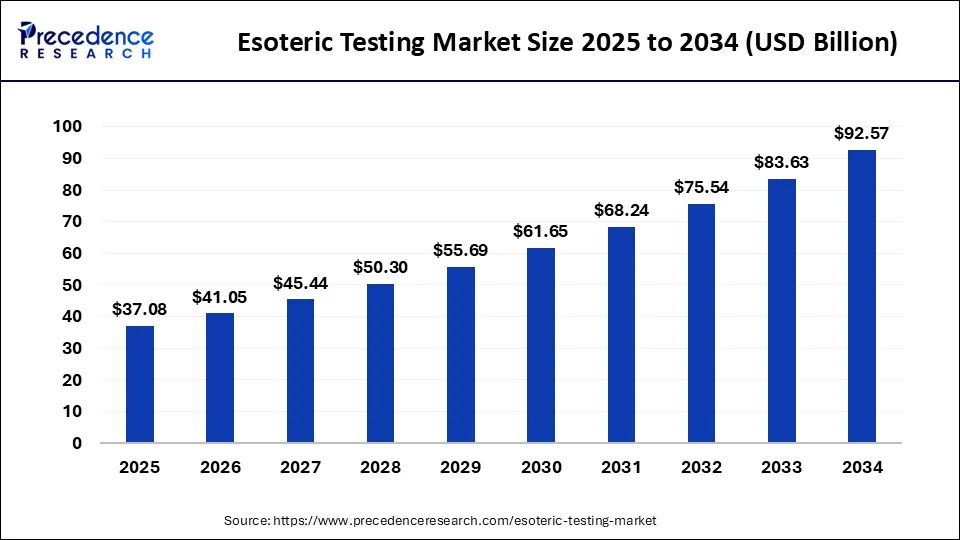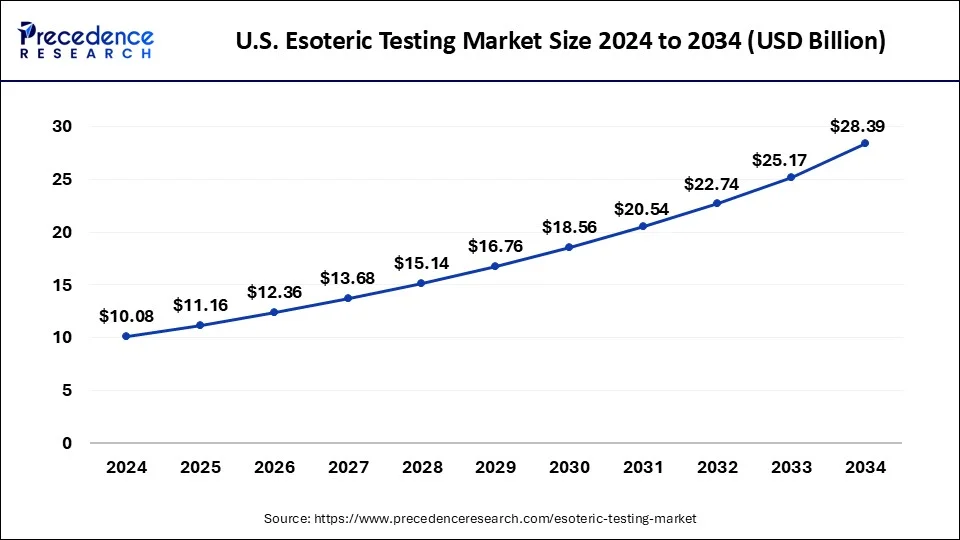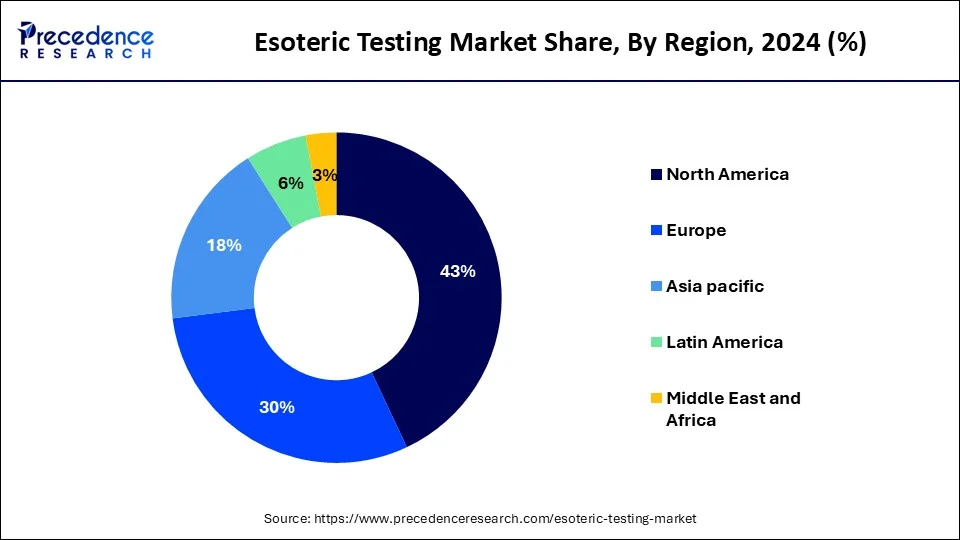August 2024
The global esoteric testing market size accounted for USD 33.50 billion in 2024, grew to USD 37.08 billion in 2025 and is predicted to surpass around USD 92.57 billion by 2034, representing a healthy CAGR of 10.70% between 2024 and 2034. The North America esoteric testing market size is calculated at USD 14.41 billion in 2024 and is expected to grow at a fastest CAGR of 10.82% during the forecast year.
The global esoteric testing market size is estimated at USD 33.50 billion in 2024 and is anticipated to reach around USD 92.57 billion by 2034, expanding at a CAGR of 10.70% from 2024 to 2034.

The U.S. esoteric testing market size is evaluated at USD 10.08 billion in 2024 and is predicted to be worth around USD 28.39 billion by 2034, rising at a CAGR of 10.89% from 2024 to 2034.

The biggest portion of the international market was controlled by the United States, which accounts for the largest share. This enormous global unit health spending, the sizable number of elderly and medical conditions such as diabetes clients, and the existence of top corporations in the area all contribute to North America's predominance. Due to an increased incidence of degenerative illnesses, growth in the screening procedures, and technical advancements in obscure screening, North America liberated the global market of exotic diagnostics throughout 2023 and therefore stays estimated to continue doing so during the projected timeline.

Moreover, due because of an increase in the incidence of degenerative illnesses, a start rising in policy measures for clinical testing, a massive rise in the supply of Enzyme-linked immunosorbent assay as well as RT-PCR tests, and an increased public understanding of the advantages of personality testing, India is predicted to have had the fastest growth from next upcoming year. The world's largest portion of the world market was in the United States, followed by the UK. The significant market percentage in the United States is likened to the nation's well-established obscure factors driving the growth, which is fueled by rising healthcare spending per person, the presence of major market players, growing utilization take effective measures, the nation's increasing prevalence, and indeed the development of personalized medicine.
Esoteric testing enables the examination of uncommon substances or compounds that are typically not studied in a medical lab. Large commercial laboratories frequently contract out challenging testing to standard and specialist testing centers. Therefore, as diagnostic test technology progresses, tests that are currently thought to be esoteric may end up being commonplace in a short period. Committed research & development professionals usually produce this. These tests are requested by doctors when they require more detailed information than routine lab testing to finish a diagnosis, determine a prognosis, or select and track a treatment plan.
Esoteric testing frequently requires the use of sophisticated tools and equipment, as well as skilled personnel to conduct the test and analyse the results. Generally speaking, these tests are much more significant and performed more regularly than standard tests. Esoteric testing includes, for example, tests in endocrinologists, genetics, immunological, microbiological, molecular techniques, cancer, serological tests, and toxicology. The field of clinical techniques is the one within esoteric clinical studies that is expanding the quickest. Finding medical technologists with the requisite training and paying employees the higher wages that respective skill sets require are two issues faced by labs that perform such procedures. Furthermore, the materials needed for these tests can be costly, especially as they are infrequently purchased in sufficient quantities to be eligible for the economy of scale.
Allergy, platform pathologists for complicated anatomic abnormalities, indicators for bones, genetic analysis, HLA genotyping, autoimmune response functional assays, and environmental toxicological are just a few of the competencies that are accessible in the labs that do these tests. Among the institutions that perform these procedures in the U. S. are Architects Facility, Mayo Healthcare Laboratory, Analysis and information Corporation, and Medical Corporations of America, as well as an increasing number of specialized esoteric testing centers that provide proprietary esoteric assays. Examples of such specialty testing lab businesses are Myriad Genomics, Genetic Healthcare, and Basis Medicine.
Globally, the major objective of healthcare practitioners is to add value to patients and provide high-quality medical treatment. Health care organizations are eager to adapt their business models, offer their services for fair prices, and concentrate on enhancing patient health. This has caused a significant focus on outsourcing complicated clinical tests, which has contributed to global growth trends in the obscure diagnostics market. It is more probable also that the industry is expected to grow considerably within the next decade as a result of the numerous specializations seen in the medical field as well as the wide variety of application areas of esoteric testing from across domains of serological testing, pharmacology, bacteriology, diagnostic tools, genetics, cardiology, immunology, and forensic science.
The necessity need personalized genomics technologies in healthcare has extended the reach of forecasting and analyzing medication responses, pharmaceutical expansion, and the increasing prevalence of diseases. Furthermore, the industry's expansion would be constrained in the predicted timeframe by strict laws and a lack of expertise in emerging markets. In turn, this will neutralize the adverse effects of the obstacles to the economic surge during the following few years. These tests are carried out after additional details outside of regular laboratory tests are needed for an accurate diagnosis of a condition, to create a forecast, or to choose and oversee a therapy course of action. Because esoteric analysis uses complicated machines and equipment, competent professionals are needed to test the study hypotheses and analyze the data.
High price, the testing will be carried out by specialized and autonomous medical research facilities. The size of the specialized market studied will be driven by the increase in complex disorder occurrences and awareness campaigns for these diseases’ early detection and treatment. In addition, third-party telecommunications companies have placed a focus on improving the efficiency of their global supply chain, assuring that healthcare units have only access to systems. The growth of the specialized testing sector will be hampered by a scarcity of expertise and a dearth of training programs on the subject for recent graduates.
Additionally, the expense of the materials required to conduct these tests results in externalities, further reducing the business's potential. In the coming years, the desire for specialized testing should increase due to the increasing frequency of highly contagious viral diseases including cancer, diabetes, and other similar conditions. Moreover, the development of esoteric research will be accelerated over time by technical developments like antidote mechanization, standardization of cutting-edge instruments, and analytic software. Business expansion will be aided by rising interest in pharmacogenomics as well as increasing funding for the creation of cutting-edge body identification testing methods.
| Report Coverage | Details |
| Market Size in 2024 | USD 33.50 Billion |
| Market Size by 2034 | USD 92.57 Billion |
| Growth Rate from 2024 to 2034 | CAGR of 10.70% |
| Base Year | 2023 |
| Forecast Period | 2024 to 2034 |
| Segments Covered | Type, Technology, End User, Geography |
The business of esoteric testing was dominated by the industry that tested for infectious diseases. The entirety of the section's growth can be attributed to the rising incidence of chronic diseases, technological changes in clinical techniques, and improving health facilities in emerging nations. The genetic screening market stays estimated to expand at a rapid speed during the projection. The rapid expansion in the genotyping market can be attributed to developments in sequencing data like NGS as well as heightened understanding.
Because of an escalation in the frequency of infectious diseases, the expansion of healthcare laboratories, and improvements in molecular diagnostic technologies, the communicable diseases testing segment accounted for the largest in 2023 and is anticipated to maintain this tendency in during the projected period.
Furthermore, due to the rise in the frequency of genetic illnesses, the requirements increase for stem cell biology initiatives, and the rise in demand for sequencing frameworks, the genetic screening segment is anticipated to have significant market expansion throughout the forecast timeframe.
This market for specialized screening was dominated by CLIA. Due to the rising prevalence of the immune disorder, diabetes, heart problems, and melanoma, as well as the progression of Research and innovation for product development and manufacturing events, the chemiluminescence enzyme-linked- linked immunosorbent assay segment held the largest share esoteric diagnostics industry in the next year and is anticipated to maintain this general pattern even during the forecast timeframe. Its benefits over some other testing techniques, which would include peak performance, sensitivity, and selectivity, needs in terms, of signal power strength, and two attributes, could be attributed to this company's sizeable share of the market.
The pervasiveness of communicable diseases like liver damage, AIDS, neurodegenerative problems, hemorrhagic fever, and melanoma is projected to rise even during the projected timeframe, along with the aging populations and the growing preference for affordable diagnostic testing services. Moreover, this same Generation sequencing region is predicted to experience significant growth throughout the estimated timeframe.
Individual and reference institutions make up a significant amount of the specialized market studied. The majority is caused by the increased testing volumes. Additionally, growth is being fuelled by the continuous automation technology of laboratory testing, the rise in the national accreditation board, the extent of payment covering, and the aggressive incentives provided by these suppliers. The sector is expanding as just a result of continuous diagnostic laboratory automation technology, an increase in independent labs, extensive insurance coverage, and aggressive incentives provided by all these suppliers.
Due to increasing examination throughput, development in some programs, and a spike in the digitization of laboratory testing, the autonomous and comparison research facilities sector, which made it popular throughout 2023, stays estimated to uphold the situation tendency even during the projected timeline.
Furthermore, owing to the increase in long-term term illness frequency, advancements in clinical laboratories, and growing demand for preventative medicine, this healthcare research labs sector is estimated to have significant growth over the coming years.
By Type
By Technology
By End User
By Geography
For inquiries regarding discounts, bulk purchases, or customization requests, please contact us at sales@precedenceresearch.com
No cookie-cutter, only authentic analysis – take the 1st step to become a Precedence Research client
August 2024
February 2025
December 2024
February 2025